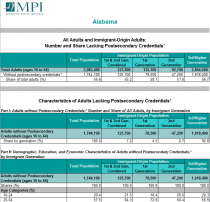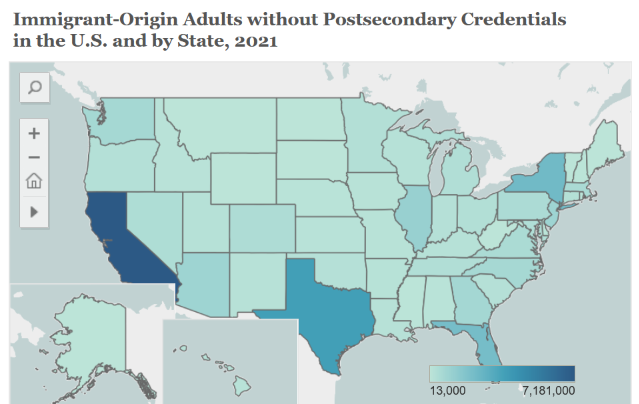Credentials for the Future: Mapping the Potential for Immigrant-Origin Adults in the United States
As the U.S. workforce ages, baby boomers retire, and birth rates decline, the United States is facing an estimated shortfall of 8 million workers between now and 2027. At the same time, the U.S. economy is becoming ever more knowledge-based. Having a marketable postsecondary credential, whether an academic degree or a professional certification or license, has become more of a necessity to secure a job that pays a family-sustaining wage.
Amid these economic changes, immigrant-origin adults—that is, immigrants and their U.S.-born children—are projected to be the primary source of future labor-force growth. Yet about 30 million of the 58 million immigrant-origin adults in the country as of 2017 did not have a postsecondary credential, representing 30 percent of all U.S. adults without one. These immigrants and their children are thus an important target group for efforts by governments, educational institutions, civil society, and employers to boost the credential attainment of U.S. workers.
This report offers a first-of-its-kind profile of immigrant-origin adults without postsecondary credentials, including a look at key sociodemographic characteristics, geographic distribution, and factors such as English proficiency and legal status that can affect their access to workforce programs. It also considers the labor-market returns of nondegree credentials, finding that immigrant-origin adults who hold such certifications or licenses have higher rates of labor-market participation, higher wages, and lower unemployment than counterparts who lack them.
“Helping a significant share of these 30 million immigrant-origin adults obtain postsecondary credentials,” the authors conclude, is “a critical tool in meeting national and state education goals, addressing current and projected labor shortages, and raising labor productivity.”
I. Introduction
A Pressing Challenge in Changing Times: Demographic, Economic, and Policy Context
II. Characteristics of the Immigrant-Origin Adult Population
III. Profile of Immigrant-Origin Adults without Postsecondary Credentials
A. What Share of Adults Lack a Postsecondary Credential?
B. What Share of U.S. Adults without Postsecondary Credentials Are of Immigrant Origin?
C. What Share Are Racial and Ethnic Minorities?
D. Where Do Most Immigrant-Origin Adults without Postsecondary Credentials Live?
E. What Share of Adults without Postsecondary Credentials Are of Immigrant Origin in Different States?
F. What Legal Statuses and Levels of English Proficiency Do These Adults Have?
IV. The Economic Returns of Nondegree Credentials for Immigrant-Origin Adults
A. Nondegree Credentials, Labor-Force Participation, and Unemployment
B. Nondegree Credentials and Wages
V. Policy Implications
A. Immigrant-Origin Adults: An Important Target Group for Credentialing Programs
B. Pursuing Credentials in a Shifting Policy Landscape





